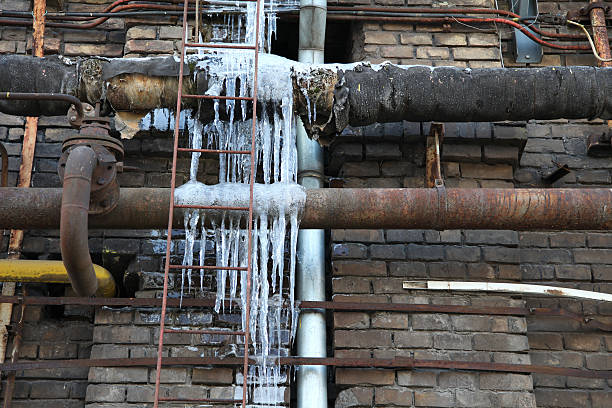Frozen pipes can turn a cold winter night into a nightmare. Imagine waking up to no running water or discovering a burst pipe flooding your home. These problems aren’t just annoying—they can cause serious damage and lead to costly repairs. Knowing how to prevent frozen pipes and what to do if they freeze can save you time, money, and stress. Being prepared is your best defense during the cold months.
Contents
Understanding Frozen Pipes
What Are Frozen Pipes?
When the temperature outside drops below freezing, water inside your pipes can freeze. As water turns to ice, it expands, which puts pressure on the pipe walls. This pressure can cause pipes to crack or burst, leading to leaks and flooding inside your home. Pipes most at risk are those exposed to outdoor air or unheated spaces. Concrete walls, attics, basements, and garages often hide vulnerable pipes that are easy to forget about.
Common Signs of Frozen Pipes
How can you tell if your pipes are frozen? Look for these clues:
- No water coming out of faucets or significantly reduced flow.
- Strange noises like banging or gurgling sounds.
- Frost or condensation visible on the outside of pipes.
- Cracked or burst pipes, especially after a strong freeze.
Causes and Risk Factors
Certain conditions make pipes more likely to freeze:
- Outdoor temperatures dropping below freezing.
- Poor insulation around vulnerable pipes.
- Pipes located near exterior walls or in unheated spaces.
- Areas with little or no heat, like attics or garages.
If your home has these features, you need to be extra cautious.
Prevention Strategies for Frozen Pipes
Insulation and Pipe Protection
Proper insulation is your first line of defense. Use foam pipe sleeves or wrap heat tape around pipes in exposed areas. Seal gaps around pipes where warm air might escape. Don’t forget to insulate spaces like attics, crawl spaces, and garages—these spots are prime freeze zones.
Maintaining Temperature
Keeping the inside of your home warm can help. Set your thermostat to at least 55°F, even if you’re away or asleep. Opening cabinet doors under sinks allows warm air to circulate around pipes. During especially cold nights, let your faucets drip slowly—running water is less likely to freeze.
Additional Precautions
- Install frost-proof outdoor faucets to prevent freezing.
- Disconnect garden hoses and drain outdoor fixtures before winter hits.
- Keep garage doors closed if pipes run through that space.
Technological Solutions
Smart thermostats can alert you if indoor temperatures drop too low. Temperature sensors placed near pipes can notify you of cold spots. These devices help catch problems before they turn into emergencies.
Emergency Response and Thawing Frozen Pipes
Immediate Steps to Take
If you suspect a frozen pipe, act fast. Turn off the water supply to prevent the pipe from bursting. Locate the frozen section carefully. Never use open flames or torches to thaw pipes—these pose fire hazards and can damage pipes. Also, you can contact a plumber for pipe repair in Orange County.
Safe Thawing Techniques
- Use a hairdryer on low heat, starting at the faucet end.
- Apply warm towels or use space heaters near the frozen area.
- Gradually run warm water through the pipe to help it thaw safely.
When to Call a Professional
If the pipe is severely cracked, remains frozen despite your efforts, or if you see leaks and water damage, call an expert. Professionals have the tools and experience to thaw pipes safely and prevent further damage.
Preventing Further Damage
After thawing, watch for leaks or cracks. Check your insulation and repair any weak spots. Clear out water-damaged materials and make sure your home drains properly to prevent future issues.
Cost of Frozen Pipes and Damage
Frozen and burst pipes can cause thousands of dollars in damage. Repairs for burst pipes average around $2,500 but can go much higher depending on the damage. Versus that, investing in prevention costs a lot less. Many insurance policies cover pipe damage, so keep good records of any repairs.
Real-World Examples and Case Studies
Many areas hit by winter storms see a surge in frozen pipe problems. In some cities, community efforts include offering free insulation or emergency repairs for residents. Proper insulation, early warnings, and quick action make a big difference. Some cold-climate homes even use smart sensors to monitor pipe temperatures constantly.
Expert Advice and Resources
Plumbers say that winterizing your pipes early saves headaches later. HVAC professionals recommend checking insulation and sealing leaks now—before the first big freeze. Utility companies often provide tips, alerts, and emergency contact info. Local home improvement stores sell supplies like foam sleeves and heat tape, and many offer free advice.
Conclusion
Preventing frozen pipes begins with simple, proactive steps. Insulate vulnerable pipes, keep your home warm, and stay alert during cold snaps. If pipes do freeze, quick, safe thawing can avoid expensive damage. Being prepared means you can enjoy the winter months without surprises. Act now—winter is coming, and so are frozen pipes! Protect your home and stay ahead this season.



